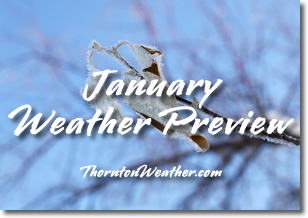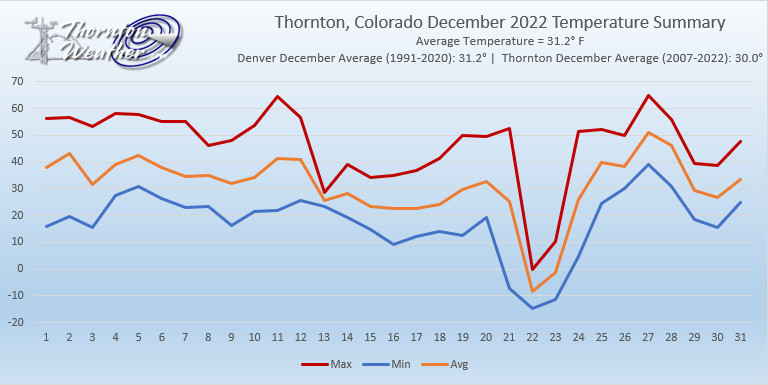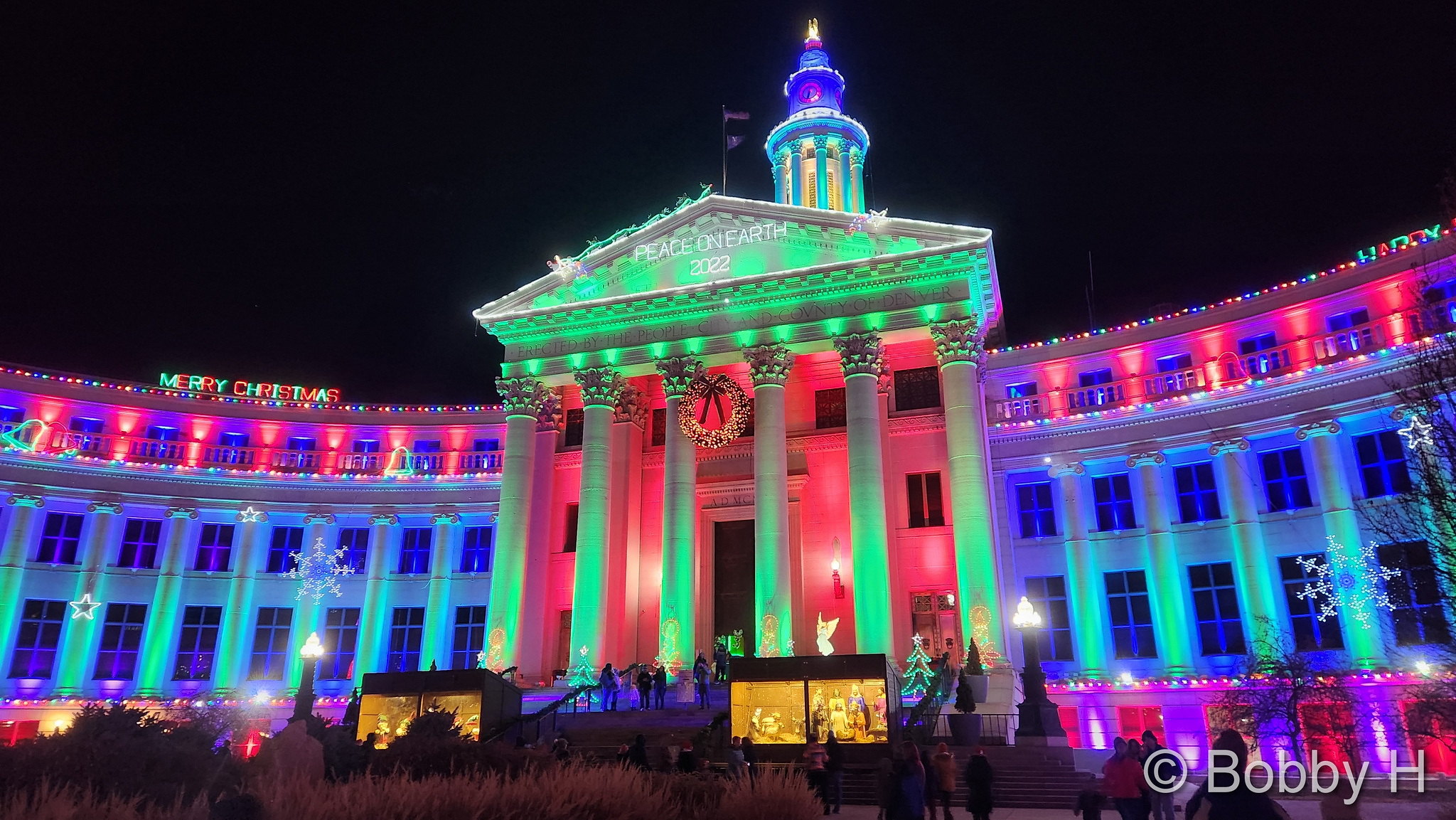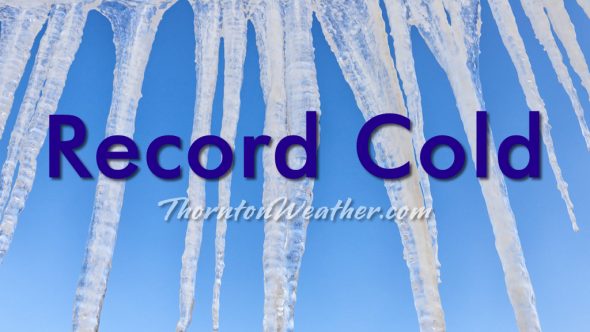January in Colorado is known for two main weather conditions – cold and wind. Our look back at this week in Denver weather history shows why this reputation is well earned.
From the National Weather Service:
7-8
In 1911…gale force winds occurred in Boulder causing minor injuries.
In 1937…cold arctic air plunged temperatures below zero for an estimated 56 consecutive hours. Two temperature records were set. High temperatures of 8 degrees below zero on the 7th and 3 degrees on the 8th were record low maximum readings for those dates. Low temperatures plunged to 12 degrees below zero on the 7th and 11 degrees below zero on the 8th. Snowfall was 1.4 inches in downtown Denver.
In 1969…a violent evening windstorm struck Boulder and the adjacent foothills. A wind gust to 130 mph was recorded at the National Center for Atmospheric Research. Winds reached 96 mph in downtown Boulder. The Boulder airport wind recorder was blown away after measuring a wind gust to 80 mph. The windstorm caused over one million dollars in damage and one fatality in Boulder. About 25 homes in south Boulder had roofs blown off or were severely damaged. Roofs were blown off buildings housing scientific laboratories and offices of the Environmental Science Services Administration…now NOAA…in Boulder…and installations of several scientific measuring sites near Boulder received heavy damage. Grass fires driven by the high winds endangered many areas…but were controlled by volunteer firemen. One man died from injuries received when he was blown from a fire truck. One man was killed and another injured when the truck camper in which they were riding was blown off I-25 about 10 miles north of Denver. In the same area a mobile home and a truck trailer were blown off the highway and demolished. At least 20 people in the Boulder area received light to serious injuries from flying debris or from being blown into obstructions. Power lines and trees were downed over a wide area. Damage was relatively light in the city of Denver…where northwest winds gusted to 62 mph at Stapleton International Airport on the 8th. Many windows were broken in Arvada…Englewood…and Littleton. A 27-year-old fire lookout tower on Squaw Mountain…west of Denver…was blown away…and several radio relay towers at that location were toppled. Trucks were overturned near Georgetown. Mobile homes were overturned in several areas with occupants receiving injuries in some cases. The strong Chinook winds also brought warm weather. The maximum temperature of 69 degrees on the 7th broke the old record of 65 degrees set in 1948. The temperature also reached 65 degrees on the 8th…but was not a record.
In 1992…an intense blizzard buried eastern parts of metro Denver. At times snow fell at rates of 2 to 3 inches an hour. Winds increased from the north at speeds of 25 to 45 mph. Drifts of 4 to 8 feet were common. I-70 was closed east of Denver…and I-25 was closed from Denver south. Snowfall totals ranged from a couple of inches in the foothills west of Denver to as much as 2 feet on the east side of metro Denver. The heaviest snow fell on the 7th in a band from the northern suburbs of Westminster and Thornton through Aurora and east Denver to southeast of Parker. Snowfall totals included: 22 inches in southeast Aurora…14.8 inches at Stapleton International Airport…13 inches in Northglenn…10 inches in Parker…and 9 inches in Westminster. The 14.5 inches of snowfall measured on the 7th into the 8th is the greatest 24 hour snowfall ever recorded in the city during the month of January. North winds gusting to 46 mph caused much blowing snow at Stapleton International Airport.
In 2000…high winds developed in and near the Front Range foothills. The strongest winds were generally confined to foothills areas north of I-70. A wind gust to 76 mph was reported in Golden Gate Canyon. West winds gusted to 37 mph at Denver International Airport on the 8th.
7-10
In 1962…a major winter storm dumped 13.5 inches of snow on metro Denver. A foot of the snow fell on the 8th when northeast winds gusted to 30 mph. The storm was followed by an intense blast of very cold arctic air. Minimum temperature readings of 24 degrees below zero occurred on both the 9th and 10th. The temperature never reached above zero on the 9th when a maximum reading of 1 degree below zero was recorded. Temperatures were below zero for 37 consecutive hours.
8
In 1912…northwest winds were sustained to 40 mph with gusts to 45 mph in downtown Denver.
In 1971…wind gusts to 52 mph were recorded in downtown Boulder. Northwest winds gusted to 28 mph at Stapleton International Airport.
In 1990…high winds gusting from 50 to 90 mph along the Front Range produced much damage from blowing dust and gravel throughout the day. Wind gusts to 92 mph were recorded in the Table Mesa area of southwest Boulder. The winds caused sporadic power outages. Clouds of dust and gravel whipped by 70 to 90 mph gusts blinded commuters on the Denver-Boulder Turnpike near Broomfield during the morning rush hour. Flying gravel shattered windows on 50 vehicles parked near a Boulder high school. High winds were also blamed for partially dismantling a house under construction in Boulder…as well as toppling a number of fences…billboards…signs…and power poles. The strong cross-winds jack-knifed and overturned semi-tractor trailers on I-70 near Golden and just south of Boulder on State Highway 93. Several county airports were closed due to strong winds and blowing dust reducing visibilities. Wind delays up to 30 minutes occurred at Stapleton International Airport where west winds gusted to 48 mph. Eighty mph winds in Georgetown…Empire…and Idaho Springs were blamed for power and telephone outages. Windows were blown out of a sheriff’s car along I-70 east of Georgetown. The strong Chinook winds warmed the temperature to a high of 60 degrees in Denver.
In 2007…strong winds associated with an intense upper level jet…and a very strong surface pressure gradient…developed in and near the Front Range foothills. Peak wind gusts ranged from 77 mph to 115 mph. The strong winds coupled with freshly fallen snow resulted in whiteout conditions and several highway closures due to blowing and drifting snow. Road closures included: State Highway 93 between Golden and Boulder; State Highway 128 from Wadsworth Boulevard to State Highway 93; U.S. Highway 36…the Denver Boulder Turnpike from Broomfield to South Boulder Road; and State Highway 74 near Evergreen…between County Road 65 and Lewis Ridge Road. More than 100 people were stranded in their cars between Golden and Boulder as blowing and drifting snow made the highway impassable. Snow drifts along State Highway 93 were over 6 feet in depth. As a result… The American Red Cross opened a shelter at Arvada West High School for the stranded commuters. Up to twenty cars were also abandoned along the Diagonal Highway…between Boulder and Longmont. Thirty vehicles were stranded along State Highway 128. The high winds also caused intermittent power outages in Boulder. West winds gusted to 40 mph at Denver International Airport
8-9
In 1891…heavy dry snowfall totaled 9.7 inches over downtown Denver. Most of the snow…6.5 inches…occurred on the 8th when north winds were sustained to 12 mph with gusts to 20 mph.
In 1939…heavy snowfall totaled 6.7 inches in downtown Denver. The snowfall was the heaviest overnight…particularly during the early morning hours. The moist snow adhered to the north side of the instrument shelter and other objects to a depth of 2 inches. Snow accumulated on fences and trees to several inches. This was the greatest snowfall of the month that year. The greatest depth on the ground was 6.5 inches. North to northwest winds were sustained to 24 mph on the 8th and to 27 mph on the 9th.
8-10
In 1983…winds of 70 to 90 mph howled through Boulder. A wind gust to 100 mph was recorded on Fritz Peak near Rollinsville. A tree blown down by the wind damaged a house in eastern Boulder County. The strong winds developed behind a cold front late on the 8th and continued through the 10th. At Stapleton International Airport…west to northwest winds gusted to 49 mph on the 8th…to 45 mph on the 9th…and to 48 mph on the 10th.
9
In 1875…the all time lowest recorded official temperature in Denver…29 degrees below zero…occurred between 3:00 am and 4:00 am under clear skies with calm winds. The temperature climbed to zero at noon and to a high of 8 degrees at 3:00 pm.
In 1916…Chinook winds from the southwest sustained to 42 mph with gusts as high as 48 mph warmed the temperature to a high of 57 degrees.
In 1917…Chinook winds…southwesterly in direction…sustained at 43 mph with gusts to 48 mph warmed the temperature to a high of 55 degrees. The low temperature was only 43 degrees.
In 1950…strong west winds to 50 mph produced blowing dust… Which briefly reduced visibility to 3/4 mile at Stapleton Airport.
In 1957…west-northwest winds gusted to 51 mph at Stapleton Airport.
In 1988…a wind gust to 61 mph was recorded at Echo Lake. West winds gusted to only 16 mph at Stapleton International Airport.
In 1989…strong Chinook winds howled along the eastern foothills. A peak gust to 115 mph was recorded at the Boulder airport where a light plane was severely damaged when the wind flipped it over. Gusts reached 103 mph at Table Mesa in south Boulder. Homes in the city suffered damage to roofs…gutters…and siding. Fences were blown down…and windows in both homes and cars were broken. A radio station was off the air for 2 1/2 hours when the winds blew the top 80 feet off its 180-foot transmission tower. A school roof was partially torn off…and a few traffic signals were downed. Winds 60 to 80 mph were reported at Jefferson County Airport in Broomfield. West winds gusted to 47 mph at Stapleton International Airport.
In 1990…high winds buffeted the Front Range foothills for a second straight day. Wind gusts to 92 mph were recorded at Rollinsville. Wind gusts of 65 to 90 mph were noted in the Denver-Boulder area. No significant damage occurred. Northwest winds gusted to 38 mph at Stapleton International Airport where the maximum temperature reached 63 degrees.
In 2017…high winds developed in and near the Front Range Foothills. Peak wind gusts included: 90 mph near Pleasant View…88 mph near Louisville…87 mph near Gold Hill… 79 mph at the NCAR Mesa Laboratory…76 mph at Glen Haven… 60 mph in Littleton…and 58 mph in Arvada. Scattered outages affected approximately 2400 customers in Boulder and Jefferson Counties. In Berthoud…strong winds destroyed a barn. At Denver International Airport…a peak wind gust of 56 mph from the northwest was recorded.
9-10
In 1962…the low temperature plunged to 24 degrees below zero on both days.
In 1972…a west wind gust to 60 mph was recorded at Stapleton International Airport…while in Boulder a wind gust to 86 mph was recorded at the National Bureau of Standards. The roof of a house was blown off…and trees were blown down in Boulder. The high winds contributed to the damage from a building fire in Boulder.
In 2000…heavy snow and strong winds in the mountains spilled into the Front Range foothills. Ward…northwest of Boulder…received 9 inches of new snow. Wind gusts to 91 mph were measured in Golden Gate Canyon…with gusts to 77 mph at Loveland Ski Area and to 73 mph along State Highway 93 north of Golden. West winds gusted to 44 mph at Denver International Airport on the 9th.
In 2011…a winter storm brought moderate to heavy snowfall to areas in and near the Front Range foothills and Palmer Divide. Storm totals included: 13 inches…3 miles south of Golden; 11.5 inches near Eldorado Springs…10.5 inches… 2 miles southwest of Boulder; 10 inches…3 miles southwest of Roxbourough State Park; 9 inches at Genesee…8.5 inches in Arvada…4 miles south-southeast of Bennett and Greenwood Village…8 inches…8 miles south of Elizabeth; 7 inches at Commerce City and 6.5 inches near Louisville and at Denver International Airport. Gusty winds produced snow drifts up to 2 feet deep over the Palmer Divide.
10
In 1893…strong west winds in Boulder and the adjacent foothills caused only minor damage. In Denver…northwest winds were sustained to 48 mph with gusts as high as 60 mph. The Chinook winds warmed the temperature to a high of 64 degrees and a low of only 40 degrees…which was a record high minimum for the date.
In 1911…southwest Chinook winds sustained to 44 mph warmed the temperature to a high of 60 degrees.
In 1932…the first thunderstorm ever officially recorded in Denver during January occurred in the early morning. The assistant observer heard two prolonged peals of thunder between 4:20 am and 4:25 am. Another off-duty observer was awakened by the thunder. Other people reported both thunder and lightning. Light snow was falling at the time. Pellets of graupel or hail were reported from some parts of the city. Snowfall totaled only 1.8 inches. Northwest winds gusted to 30 mph.
In 1962…as the temperature dipped to a frigid 24 degrees below zero…setting a new record minimum for the date… The pressure adjusted to sea level reached the highest ever recorded in Denver…31.24 inches (1057.8 mb). The altimeter setting reached 30.70 inches…and the actual station pressure recorded was 25.260 inches.
In 1988…strong winds occurred throughout the day in and near the foothills. Peak gusts to 85 mph were recorded at Rollinsville…84 mph at Echo Lake…and 64 mph in Boulder.
In 1990…a third consecutive day of 50 to 85 mph wind gusts occurred in and along the eastern foothills. A 5 mile portion of the Denver-Boulder turnpike was closed after clouds of blowing dust and gravel caused several multicar accidents near Broomfield. One 59-year-old woman was killed and two others injured. A wind gust to 81 mph was recorded at the nearby Jefferson County Airport. In Boulder…wind gusts to 85 mph were blamed for ripping off a portion of a roof on a house…as well as blowing out the large picture window. West winds gusted to 41 mph at Stapleton International Airport. The warm Chinook winds set a record high temperature of 71 degrees in Denver for the date.
In 1996…strong northwest winds developed behind a pacific cold front that moved rapidly across northeast Colorado. A peak wind gust to 64 mph was recorded at the Rocky Flats Environmental Test Facility in Jefferson County. North- northeast winds gusted to 38 mph at Denver International Airport.
10-11
In 1948…strong winds were reported in Boulder and Lakewood. Winds of 50 to 60 mph were reported at Valmont…just east of Boulder. Only minor damage was reported.
In 1980…strong winds of 60 to 95 mph howled across metro Denver…causing some brief power outages and some broken windows. A wind gust to 111 mph was recorded at Wondervu. Northwest winds gusted to 40 mph at Stapleton International Airport on the 10th.
In 1999…high winds gusting to 100 mph blasted the foothills. Peak wind gusts included: 100 mph at central city…98 mph at Wondervu…82 mph at Aspen Springs and Golden Gate Canyon… 81 mph at the NCAR Mesa Lab in Boulder and near Nederland… 78 mph atop Blue Mountain near Coal Creek Canyon…and 72 mph at the Rocky Flats Environmental Test Facility. West winds gusted to 38 mph and warmed the temperature to a high of 63 degrees at Denver International Airport on the 11th.
10-12
In 1997…heavy snow fell over the Front Range foothills. A foot of new snow was measured at Blackhawk with 7 inches recorded in Coal Creek Canyon. Only 3.3 inches of snow fell at the site of the former Stapleton International Airport. East-northeast winds gusted to 18 mph at Denver International Airport on the 11th.
10-13
In 1963…an arctic cold wave plunged temperatures well below zero across metro Denver. Temperatures were below zero for a total of 64 consecutive hours. Low temperatures reached 25 degrees below zero on both the 11th and 12th. The high temperature of 9 degrees below zero on the 11th was the coldest ever recorded at Stapleton Airport and equaled the record low maximum for the month first set on January 19…1883…in downtown Denver. The high temperature on the 12th reached only 1 degree below zero. On the 12th…an 18-year-old youth died of exposure from the extreme cold in Denver. There were many losses and damage to property from frozen water systems…stalled cars…and over-burdened heating systems. Light snow accompanied the arctic blast. At Stapleton Airport…2.3 inches of snow fell on the 10th and 11th.
11
In 1887…northwest winds were sustained to 40 mph in the city.
In 1893…northwest winds to 48 mph were recorded in the city.
In 1901…northwest winds were sustained to 45 mph with an extreme velocity of 47 mph.
In 1988…strong Chinook winds blew throughout the day along the eastern foothills. Winds peaked to 75 mph in Boulder… Breaking at least one window. West winds gusted to 49 mph at Stapleton International Airport.
In 1989…2 to 3 inches of snow fell across metro Denver causing near gridlock conditions during the morning rush hour and two-hour delays at Stapleton International Airport. Two to 6 inches of snow whitened Boulder where many traffic accidents were reported. Snowfall measured 2.9 inches at Stapleton International Airport where northeast winds gusted to 21 mph.
In 1995…high winds developed in the foothills. A gust to 67 mph was recorded at Rocky Flats in northern Jefferson County. West winds gusted to only 32 mph at Stapleton International Airport.
In 1996…very strong winds were reported in the Front Range foothills for a brief time. Wind gusts to 85 mph were recorded at Golden Gate Canyon…with 95 mph at Wondervu.
11-12
In 1972…high winds howled along the Front Range foothills. A wind gust to 144 mph was recorded at the National Center for Atmospheric Research in Boulder. A wind gust to 105 mph was recorded at the Rocky Flats plant south of Boulder. Wind gusts to 90 mph were recorded in downtown Boulder. The greatest damage from the windstorm occurred in Boulder where 25 or more mobile homes were destroyed either by wind or the fires which resulted when they were overturned. Car windows were blown out; many buildings damaged; utility poles…power lines…trees…and traffic lights blown down. As many as 75 families were evacuated from a recently completed apartment building because of severe structural damage. Government and private office buildings and industrial plants were evacuated because of danger from flying glass and debris. Twelve people were treated at the hospital…mostly for cuts from flying glass. At least 15 small planes were seriously damaged and hangar doors were blown off at the Jefferson County Airport in Broomfield. Wind damage in Boulder alone totaled 2 million dollars. At Stapleton International Airport…west winds gusted to 53 mph on the 11th and to 47 mph on the 12th. The strong Chinook winds warmed temperatures into the mid 50’s on both days.
In 2019…an upslope snow event produced heavy snow in the southern Front Range Foothills and Palmer Divide…with light to moderate snowfall elsewhere. In the Front Range Foothills and Palmer Divide storm totals included: 18 inches at Schaffers Crossing…16.5 inches near Tiny Town… 15.5 inches in Pinecliffe…14 inches in Crescent Village… 13.5 inches near Aspen Park…13 inches…11 miles southeast of Arapahoe Park; 12.5 inches near Genesee and Kittredge… 12 inches near Perry Park…11 inches near Conifer…with 6 to 10 inches elsewhere. Across the western and southern suburbs of Denver storm totals included: 7.5 inches near Centennial…6 inches in Louisville and Westminster…5.5 inches in Federal Heights…5 inches in Broomfield…with 2 to 4 inches elsewhere. The official snowfall measurement at Denver International Airport was 1.3 inches.
11-14
In 1997…cold arctic air plunged temperatures below zero across metro Denver. The temperature was below zero for 60 consecutive hours from the afternoon on the 11th to around daybreak on the 14th. The high temperature of only 1 degree below zero on the 12th equaled the record low maximum for the date last set in 1963. The low temperature dipped to 14 degrees below zero on the 12th. Continue reading January 8 to January 14: This Week in Denver Weather History


 As we begin the new year the winter chill begins to set in. While January can see its share of extremes, the month historically sees stable temperatures and is usually relatively dry.
As we begin the new year the winter chill begins to set in. While January can see its share of extremes, the month historically sees stable temperatures and is usually relatively dry.



